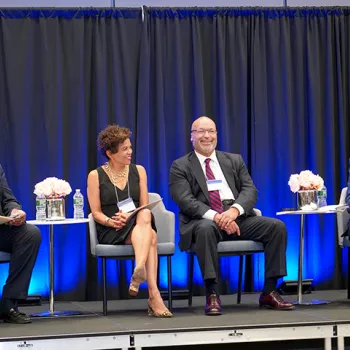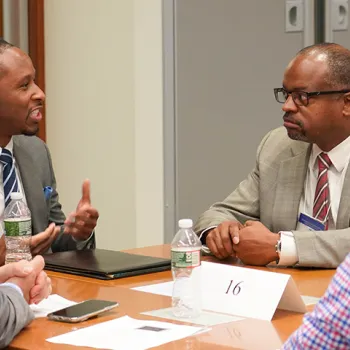Fifth Circuit U.S. Court of Appeals Judge Catharina Haynes, a child of immigrants, was encouraged from an early age to reach for the stars. But on the day she was approached about entering a race for a Texas state judgeship, she was struck with a feeling of trepidation.
“I love the law, but it just seemed so huge,” Haynes said. “Who me? A judge? I wasn’t sure if I had what it takes, and I probably wouldn’t have entered the race without my husband and fellow legal colleagues encouraging me to be a judge.”
To encourage others who likewise harbor doubts, Judge Haynes urged the nearly 1,500 attorneys and law students who registered for a diversity symposium, broadcast live to venues across the country, to repeat after her, pointing to themselves and then to each other, “Who me? Yes you!”
The Oct. 24 event, titled “Roadways to the Federal Bench: Who Me? A Bankruptcy Judge?” was sponsored by a diversity working group of the Judicial Conference of the United States in an effort to encourage law students and lawyers to take an interest in the practice area, with the goal of creating a more diverse pipeline of candidates for the bankruptcy bench. Judge Haynes, who chairs the diversity working group, participated at the event’s Dallas location.
A panel of federal judges, meeting at the District of Columbia Bar headquarters, kicked off the 19-city event by explaining bankruptcy practice, how to succeed as a judge, and the importance of diversity on the bench. The panelists were: Judge Tanya S. Chutkan, of the U.S. District Court for the District of Columbia; Judge Robert A. Gordon, of the U.S. Bankruptcy Court for the District of Maryland; Judge Frank J. Bailey, of the U.S. Bankruptcy Court for the District of Massachusetts; and retired Judge Andre M. Davis, of the Fourth Circuit U.S. Court of Appeals, who moderated.
“We are a better and stronger system with diversity on the bench. Having people from different cultural backgrounds changes perceptions and broadens your understanding of the world around you,” Bailey said. “Yet, the bankruptcy bench is the least diverse federal bench and it’s the federal court that the most people visit. I believe we can remedy this by exposing law students to the bankruptcy practice early on through outreach, internships, and collaboration with bar associations.”
Following the broadcast, each location hosted roundtable discussions. Approximately 400 federal judges attended the discussions throughout the country to speak with participants in small group settings about their paths to the bench and careers in the law.
“There’s no one path to the bench. People gain the necessary experience in a variety of ways, and hearing those stories from judges themselves demystifies the position, changes perceptions, and encourages others that they too can have a successful career in bankruptcy as a lawyer or a judge,” Bailey said.
Sallye Higgin, a retired bankruptcy attorney of 35 years who attended the event, said, “People filing for bankruptcy need to feel like they have someone presiding over their case who can relate to them. They don’t want to come to court feeling like they are approaching the enemy.”
James Gilmore, a law student at Georgetown University, came to the event hoping to gain insight from judges and to get detailed information about applying for clerkships as he prepares to begin his career.
“I first became interested in the law as a child watching legal shows on TV,” Gilmore said. “As I got older, I became more aware of the problems facing my community and realized I could use the law to fix them.”
An attorney attending the event in Los Angeles described the experience on an anonymous evaluation form.
“Honestly, I did not know what to expect and the event exceeded my expectations,” the attorney wrote. “I enjoyed the candidness of the conversation, both from the panelists as well as in the breakout sessions. I learned things that I did not know about bankruptcy. I thought bankruptcy judges only dealt with numbers.”
Judges who participated in the symposium agreed that interacting with students and lawyers outside the courtroom is an important step in building a diverse pipeline.
“As lawyers, we sometimes forget that judges are human too,” Haynes said. “I hope everyone who participated left saying, ‘Why not me?’ instead of, ‘Who, me?’”
Subscribe to News Updates
Subscribe to be notified when the news section is updated.


